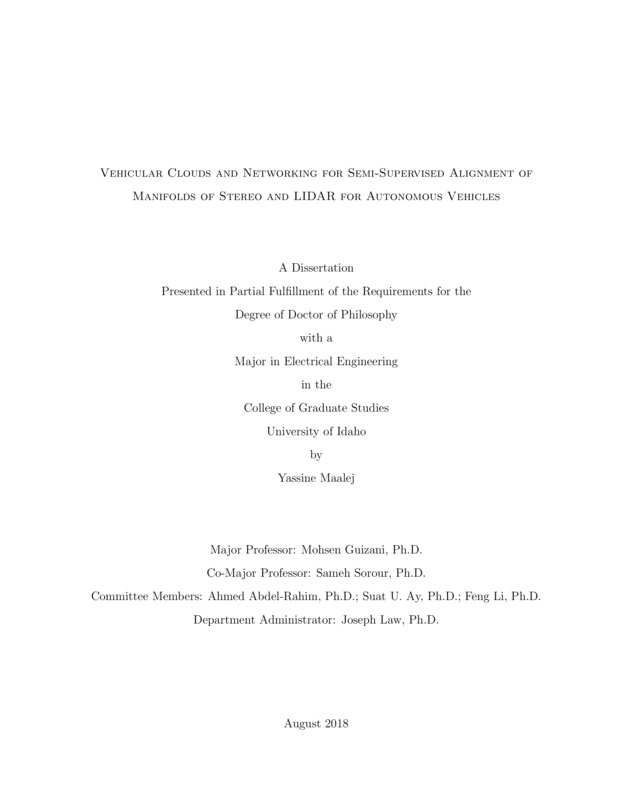Vehicular Clouds and Networking for Semi-Supervised Alignment of Manifolds of Stereo and LIDAR for Autonomous Vehicles
Maalej, Yassine. (2018-08). Vehicular Clouds and Networking for Semi-Supervised Alignment of Manifolds of Stereo and LIDAR for Autonomous Vehicles. Theses and Dissertations Collection, University of Idaho Library Digital Collections. https://www.lib.uidaho.edu/digital/etd/items/maalej_idaho_0089e_11445.html
- Title:
- Vehicular Clouds and Networking for Semi-Supervised Alignment of Manifolds of Stereo and LIDAR for Autonomous Vehicles
- Author:
- Maalej, Yassine
- ORCID:
- 0000-0003-1497-3615
- Date:
- 2018-08
- Keywords:
- Autonomous Vehicles CNN DSRC LIDAR Manifold Alignment Vehicular Clouds
- Program:
- Electrical and Computer Engineering
- Subject Category:
- Electrical engineering; Computer engineering; Artificial intelligence
- Abstract:
-
or decades, researchers on Vehicular Ad-hoc Networks vehicular ad-hoc networks (VANETs)
and autonomous vehicles presented various solutions for vehicular safety and autonomy,
respectively. Yet, the developed work in these two areas has been mostly conducted in
their own separate worlds, and barely affect one- another despite the obvious relation-
ships. In the coming years, the Internet of Vehicles Internet of Vehicles (IOV), encom-
passing sensing, communications, connectivity, processing, networking, and computation
is expected to bridge many technologies to offer value-added information for the navi-
gation of self-driving vehicles, to reduce vehicle on board computation, and to deliver
desired functionalities. Potentials for bridging the gap between these two worlds and
creating synergies of these two technologies have recently started to attract significant
attention of many companies and government agencies. We present a comprehensive
survey and an overview of the emerging key challenges related to the two worlds of Ve-
hicular Clouds (VCs) including communications, networking, traffic modelling, medium
access, VC Computing Vehicular Cloud Computing (VCC), VC collation strategies, secu-
rity issues, and autonomous driving Autonomous Driving (AD) including 3D environment
learning approaches and AD enabling deep-learning, computer vision and Artificial Intel-
ligence Artificial Intelligence (AI) techniques. We then discuss the recent related work
and potential trends on merging these two worlds in order to enrich vehicle cognition of
its surroundings, and enable safer and more informed and coordinated AD systems.
Modern vehicles are equipped with advanced communication, computation and storage
capabilities in On-Board Units (OBUs), that are used to form a Vehicular Cloud Vehicular
Cloud (VC) as coalitions of affordable resources to host infotainment applications. With
the limitation of static vehicular communication schemes and the computational capa-
bilities constraints in vehicular micro-datacenter, VCs have overcome these technological
limitations. VCs are supposed to maximize the usage of Vehicle to Infrastructure (V2I)
communications over Service Channels (SCHs) for non-safety applications while
maintaining reliable short-lived safety applications Vehicle to Vehicle Vehicle-to-Vehicle (V2V)
communications in the Dedicated Short Range Communication (DSRC) technology. We
present a novel Advanced Activity-Aware (AAA) scheme to enhance Multi-Channel Oper-
ations based on IEEE 1609.4 standard in MAC Protocol implemented in Wireless Access
in Vehicular Environments Wireless Access for Vehicular Environment (WAVE). The
developed AAA scheme relies on the awareness of the vehicular safety load. It aims at dy-
namically finding an optimal setup for switching between Service Channel Interval (SCHI)
and Control Channel Interval (CCHI) by decreasing every inactivity in the network. Our
scheme is implemented using NS3 and maintains the default Synchronization Interval
Synchronization Interval (SI), as defined by the standard in Vehicular Ad hoc Networks
(VANETs).
In addition, we evaluate a sequentially and a parallel CUDA-accelerated Markov De-
cision Process Markov Decision Process (MDP) based scheme and a fast greedy heuristics
algorithm to optimize the problem of vehicular task placement with both IEEE 1609.4 and
opportunistically available V2I of AAA scheme. We derive the system reward of Vehicular
Cloud Computing VCC by considering the overall utilization of the virtualized resources
of the distributed Vehicular Clouds (VCs) as well as the optimality of the solution of
placement of the vehicular Bag-of-Tasks (BOTs)
We present our vision to create such a beneficial link by designing a multimodal
scheme for object detection, recognition, and mapping based on the fusion of stereo camera
frames, point cloud Velodyne LIDAR scans, and Vehicle-to-Vehicle (V2V) Basic Safety
Messages Basic Safety Messages (BSMs) exchanges using VANET protocols. Exploiting
the high similarities in the underlying manifold properties of the three data sets, and their
high neighborhood correlation, the proposed scheme employs semi-supervised manifold
alignment to merge the key features of rich texture descriptions of objects from 2D images,
depth and distance between objects provided by 3D point cloud, and awareness of self-
declared vehicles from BSMs’ 3D information including the ones not seen by camera and
LIDAR. The proposed scheme is applied to create joint pixel-to-point-cloud and pixel-
to-V2V correspondences of objects in frames from the KITTI Vision Benchmark Suite,
using a semi-supervised manifold alignment, to achieve camera-LIDAR and camera-V2V
mapping of their recognized objects. We present the alignment accuracy results over 2
different driving sequences and illustrate the additional acquired knowledge of objects
from the various input modalities. We also study the effect of the number of neighbors
employed in the alignment process on the alignment accuracy.
- Description:
- doctoral, Ph.D., Electrical and Computer Engineering -- University of Idaho - College of Graduate Studies, 2018-08
- Major Professor:
- Guizani, Mohsen; Sorour, Sameh
- Committee:
- Ay, Suat U.; Abdel-Rahim, Ahmed; Li, Feng
- Defense Date:
- 2018-08
- Identifier:
- Maalej_idaho_0089E_11445
- Type:
- Text
- Format Original:
- Format:
- application/pdf
- Rights:
- In Copyright - Educational Use Permitted. For more information, please contact University of Idaho Library Special Collections and Archives Department at libspec@uidaho.edu.
- Standardized Rights:
- http://rightsstatements.org/vocab/InC-EDU/1.0/

